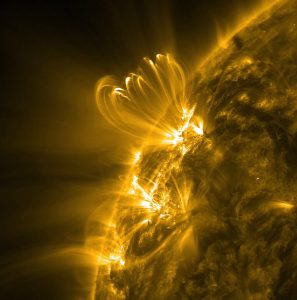Supervisor: Prof. Robert Walsh
 Our Sun is a dynamic and active star. Observed across the electromagnetic spectrum, the solar corona is revealed as a fascinating plasma physics laboratory that still challenges our understanding of the complex interactions between the electrified gases and the pervading magnetic field.
Our Sun is a dynamic and active star. Observed across the electromagnetic spectrum, the solar corona is revealed as a fascinating plasma physics laboratory that still challenges our understanding of the complex interactions between the electrified gases and the pervading magnetic field.
The aim of this project is to examine the corona on the finest observational scales currently available. Employing data from NASA’s Solar Dynamics Observatory, Hinode and NASA sounding rocket missions that UCLan is closely involved with, the research will focus on determining the highest resolution dynamic activity (in space and time) across the solar corona. It is envisaged that the work will involve use of image enhancement and pattern recognition algorithms to further determine the extent, location and nature of the activity. Some basic modelling of the observed features will also be introduced.
This is a fruitful time for solar coronal physics research with extensive datasets available from current missions. The PhD candidate will have the opportunity to design and execute their own observational programme for these existing facilities. Also, the research will lay the groundwork for the analysis of coronal data from future missions, in particular for ESA’s Solar Orbiter. In that regard, the student will potentially be working with the supervisor’s collaborators throughout the programme (for example, NASA MSFC).
